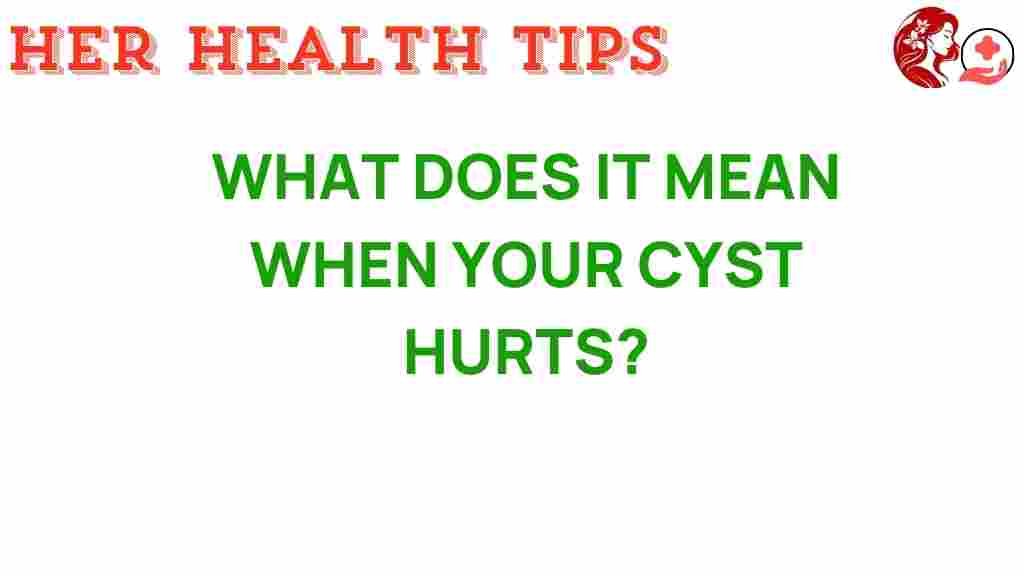Cyst Pain: Understanding the Symptoms and Their Implications
Cysts are fluid-filled sacs that can develop anywhere in the body, and while many are harmless, cyst pain can indicate an underlying issue. Understanding why your cyst hurts is crucial for women’s health and overall well-being. In this article, we will unravel the mystery of cyst pain, explore potential medical symptoms associated with it, discuss diagnosis and treatment options, and provide health insights to enhance healthcare awareness.
What Are Cysts?
A cyst is a closed sac-like structure that can be filled with fluid, semi-solid material, or gas. Cysts can develop in various body parts, including the skin, ovaries, kidneys, and liver. While many cysts are benign and asymptomatic, some can cause discomfort, pain, or other symptoms.
Common Types of Cysts
- Ovarian Cysts: These develop in or on the ovaries and can cause abdominal discomfort or pain.
- Sebaceous Cysts: These are small lumps beneath the skin, often on the face, neck, or torso.
- Baker’s Cysts: These form behind the knee and can cause pain and swelling.
- Pilonidal Cysts: These can occur near the tailbone and may become infected.
Identifying Cyst Pain and Associated Medical Symptoms
Cyst pain can manifest in various ways, depending on the type and location of the cyst. Understanding the symptoms can help you determine when to seek medical attention.
Common Symptoms of Cyst Pain
- Localized Pain: Pain that is specific to the area where the cyst is located.
- Abdominal Discomfort: Particularly relevant for ovarian cysts, which can cause bloating and pressure.
- Swelling: Visible swelling around the area of the cyst.
- Redness and Warmth: Skin changes may indicate an infection.
- Difficulty Moving: Pain may limit motion, especially with Baker’s cysts.
If you experience any of these symptoms, especially if they worsen over time, it’s essential to consult a healthcare provider.
When to Seek Medical Attention
While many cysts are harmless, certain situations warrant immediate medical advice:
- Severe pain that does not improve with over-the-counter pain relievers.
- Signs of infection, such as fever, chills, or pus.
- Changes in bowel or urinary habits.
- Persistent nausea or vomiting.
Diagnosis: How Healthcare Professionals Assess Cyst Pain
Understanding the cause of cyst pain often requires a thorough diagnosis. Here’s a step-by-step process that healthcare professionals might follow:
Step 1: Medical History Review
Your doctor will begin by discussing your medical history, including:
- Previous cysts or related conditions.
- Family history of cysts or other health issues.
- Any medications you are taking.
Step 2: Physical Examination
A physical exam allows the healthcare provider to assess the cyst and surrounding areas for tenderness, swelling, or other signs of infection.
Step 3: Imaging Tests
If necessary, imaging tests such as ultrasounds, CT scans, or MRIs may be ordered to get a clearer picture of the cyst’s size and characteristics. These tests are crucial for:
- Determining the cyst’s nature (benign or malignant).
- Identifying any complications, like ruptures or infections.
Step 4: Laboratory Tests
In some cases, fluid from the cyst may be analyzed through aspiration (removing fluid with a needle) to determine its composition and rule out malignancy.
Treatment Options for Cyst Pain
Treatment for cyst pain depends largely on its cause, type, and severity. Here are common approaches:
Conservative Management
For many cysts that cause mild pain, conservative management may be sufficient:
- Over-the-Counter Pain Relievers: Medications such as ibuprofen or acetaminophen can help alleviate discomfort.
- Heat Therapy: Applying a warm compress can reduce pain and inflammation.
- Rest: Limiting movement in the affected area can aid recovery.
Medical Interventions
If conservative treatments are ineffective, your healthcare provider may recommend more invasive options:
- Cyst Aspiration: A needle is used to drain fluid from the cyst, providing immediate relief.
- Surgical Removal: In cases of recurring or painful cysts, surgical excision may be necessary.
- Hormonal Treatments: For ovarian cysts, hormonal medications may help regulate the menstrual cycle and reduce cyst formation.
Managing Chronic Cyst Pain
For individuals experiencing chronic cyst pain, a multi-faceted approach may be beneficial:
- Physical Therapy: Can help strengthen surrounding muscles and improve mobility.
- Diet and Lifestyle Changes: Maintaining a healthy diet and staying hydrated can mitigate symptoms.
- Stress Management: Techniques like yoga and meditation can help reduce pain perception.
Troubleshooting Tips for Cyst Pain Management
While managing cyst pain, consider these troubleshooting tips to enhance your comfort:
- Keep a Pain Diary: Document when the pain occurs, its intensity, and any associated symptoms to share with your healthcare provider.
- Stay Informed: Understanding your condition empowers you to make informed decisions about your health.
- Join Support Groups: Connecting with others who experience similar issues can provide emotional support and practical advice.
Conclusion: The Importance of Healthcare Awareness
Understanding cyst pain and its implications is vital for maintaining women’s health and overall well-being. With proper knowledge and awareness, individuals can recognize symptoms early and seek appropriate care.
Always consult a healthcare professional if you experience persistent cyst pain or any concerning symptoms. Timely diagnosis and treatment can lead to better health outcomes and improved quality of life. For more detailed health insights, consider visiting the Mayo Clinic’s website for comprehensive information on cysts and related conditions.
By fostering healthcare awareness and taking an active role in managing your health, you can navigate the complexities of cyst pain and achieve effective pain management that suits your lifestyle.
This article is in the category Conditions and created by HerHealthTips Team
